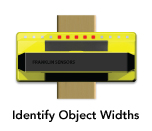ProSensor 710 FEATURES
Works Better In Real-World Conditions
Most stud finders work very well on show-floor display on a perfectly flat piece of sheet rock, with no texturing or difficult wall paper, with perfectly even paint, and with perfectly flat plaster work. However, the same stud finders can become confused when faced with real-world construction irregularities. Conventional stud finders become confused because they are only able to “see” the wall in one position at a time. A small irregularity at one position can cause a slight error, or a big error. Fortunately, the ProSensor 710 is much less vulnerable to construction irregularities because it is able to “see” the wall in multiple locations at one time. It uses readings from several points on the wall to determine what is behind the surface of the wall. The ProSensor 710 forms an image of the wall based upon many readings, which is one of the reasons that the ProSensor 710 is the most accurate stud finder on the market.
Ability to Detect 2 Objects Simultaneously

Studs in a typically home are 16” apart, and normally you can expect studs to be 16” apart. However, there are many instances where standard 16” stud spacing doesn’t happen. This occurs frequently around doors, near windows, at corners, or when extra support is needed, such as below a stairway. Around these architectural features it can be difficult to determine what wood is behind the sheetrock if you are using a conventional electronic stud finder. The ProSensor 710 makes it easy to determine what is behind the sheetrock, even if there are multiple objects of different sizes and widths. The LEDs on the ProSensor 710 illuminate in front of all hidden objects, making identification easy.

Ability to Identify Width
The ProSensor 710 is the perfect tool to identify the width of hidden objects. The ProSensor 710 illuminates all LEDs that are in front of a hidden object, so the user only needs to notice how many LEDs are illuminated to know the width what is behind the wall.
Deep Scanning

Most homes are built with sheetrock that is between 3/8” thick and 5/8” thick, and most stud finders will operate with these standard sheetrock thicknesses. However more and more homes are being built with two layers of sheetrock in select rooms. The second layer of sheetrock may be used, for example, to keep a bedroom quieter, or to line the walls of a theatre room. The ProSensor 710 has the best performance of any stud finder through thick surfaces and it has the best deep scanning capabilities of any available stud finder.
Ability to Instantly Detect
Conventional electronic stud finders require the user to slide the finder back and forth across the wall until the finder “learns” the wall. For some finders it may take multiple swipes until the finder becomes tuned into the wall and can detect accurately. Also, some conventional electronic finders don’t work well unless the finder was initiated at least 3” away from a stud. This means is that if you place the finder on the wall over a stud, and press the button, you’ll have great difficulty detecting the stud, unless you reinitiate the sequence from an alternative location. The ProSensor 710 doesn’t suffer from any of these problems. Place the ProSensor 710 on the wall in any location, press the button, and you will instantly see the location of any hidden objects. The ProSensor 710 instantly self-tunes to the wall, without sliding, and it instantly shows the location of any hidden objects.
